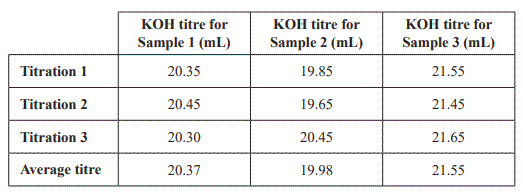1. A titration was performed to determine the concentration of an ethanoic acid, C2H4O2, solution using the following procedure:
1. 25.00 mL of the C2H4O2 solution was pipetted into a conical flask.
2. A few drops of indicator were added to the flask.
3. A burette was filled with standard sodium hydroxide, NaOH, solution.
4. The C2H4O2 solution was then titrated with the NaOH solution.
5. Steps 1–4 were repeated until three concordant titres were obtained.
A systematic error could result if the
A. burette tap leaked during one of the titrations.
B. burette readings were recorded to the nearest 0.1 mL.
C. number of drops of indicator was not consistent for each titration.
D. actual concentration of the standard NaOH solution was lower than the stated concentration.
Solution

2.A student titrated 25 mL aliquots of three different concentrations of an organic acid against a standardised potassium hydroxide, KOH, solution. The student’s results are shown in the table below.

Which one of the following statements is consistent with the results shown in the table?
A. Sample 2 is the most concentrated acid.
B. Sample 3 is the most concentrated acid.
C. There is not enough information to draw a valid conclusion.
D. The averages in the table are correct as the results are concordant.
Solution
3. The loss of vitamin C, C6H8O6 , in sweet potato after heating can be determined in a titration by reacting vitamin C with iodine, I2 , solution. The balanced titration equation is shown below.
C6H8O6(aq) + I2(aq) → 2HI(aq) + C6H8O6(aq)
A sample of sweet potato was blended with water and filtered. The filtrate was titrated against 0.0500 M of I2(aq). The average of three concordant titres was 21.81 mL. Calculate the mass of vitamin C in the sweet potato sample.
